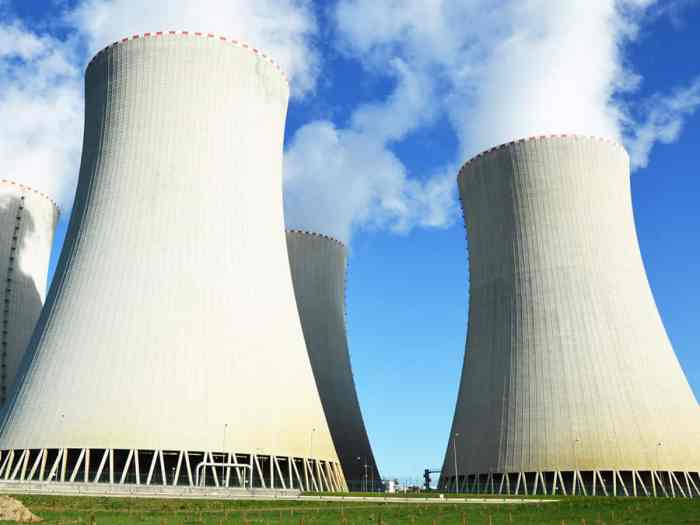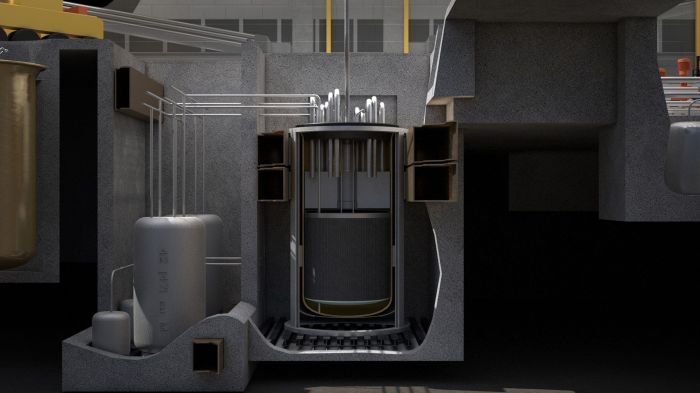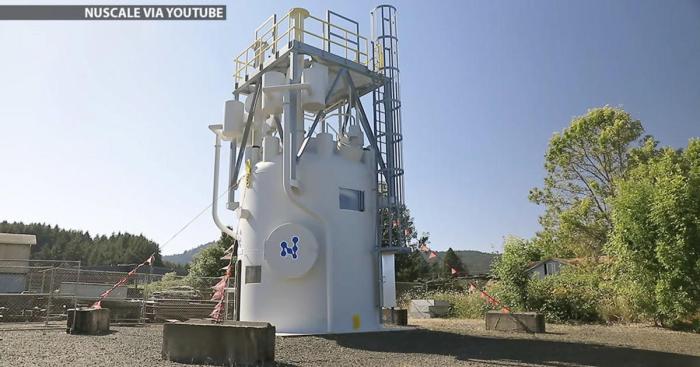Small nuclear reactors are gaining attention as a promising solution to the world’s energy challenges. These innovative technologies offer numerous advantages over traditional nuclear reactors, including increased efficiency, cost-effectiveness, and enhanced safety. As we delve into the realm of small nuclear reactors, we will explore their benefits, drawbacks, applications, and future prospects.
Small nuclear reactors, with their compact size and modular design, present a unique opportunity to revolutionize the energy sector. Their potential to provide reliable, clean, and affordable energy holds immense promise for a sustainable future.
Introduction

Small nuclear reactors (SMRs) are a type of nuclear reactor that is significantly smaller than traditional nuclear reactors. They typically generate less than 300 megawatts of electricity, compared to traditional nuclear reactors which can generate over 1,000 megawatts. SMRs are designed to be more flexible, affordable, and safer than traditional nuclear reactors, making them a potential option for providing clean energy in a variety of applications.The history of SMRs dates back to the early days of nuclear power.
In the 1950s and 1960s, several small nuclear reactors were built for military and research purposes. However, it was not until the 1970s that SMRs began to be developed for commercial use. In the 1980s, several SMR designs were proposed, but none were ultimately built.In recent years, there has been a renewed interest in SMRs.
This is due to a number of factors, including the growing need for clean energy, the falling cost of renewable energy, and the increasing safety concerns about traditional nuclear reactors.
Advantages of Small Nuclear Reactors
Small nuclear reactors (SMRs) offer several advantages over traditional large nuclear reactors. They are more efficient, cost-effective, and safer, making them an attractive option for meeting future energy needs.
One of the key advantages of SMRs is their efficiency. SMRs operate at higher temperatures than traditional reactors, which allows them to convert more of their fuel into electricity. This increased efficiency results in lower fuel costs and reduced greenhouse gas emissions.
Cost-effectiveness
SMRs are also more cost-effective than traditional reactors. They are smaller and simpler to build, which reduces construction costs. Additionally, SMRs can be built in modular units, which allows for economies of scale. This makes SMRs a more affordable option for developing countries and remote areas.
Safety
SMRs are also safer than traditional reactors. They have a number of passive safety features that make them less likely to experience a nuclear accident. For example, SMRs use natural circulation to cool the reactor core, which eliminates the need for pumps and other mechanical systems that could fail.
Additionally, SMRs are designed to withstand earthquakes and other natural disasters.
Disadvantages of Small Nuclear Reactors

Small nuclear reactors have several drawbacks compared to traditional reactors. They can be less reliable, have higher operating costs, and produce less power.
One of the main disadvantages of small nuclear reactors is that they can be less reliable than traditional reactors. This is because they have fewer redundant systems and components, which means that if one component fails, the entire reactor may have to be shut down.
Additionally, small nuclear reactors are often located in remote areas, which can make it difficult to get maintenance and repairs.
Operating Costs
Another disadvantage of small nuclear reactors is that they have higher operating costs than traditional reactors. This is because they require more staff to operate and maintain, and they have to be refueled more often. Additionally, small nuclear reactors often have to be built in remote areas, which can add to the cost of construction and operation.
Power Output
Finally, small nuclear reactors produce less power than traditional reactors. This means that they are not suitable for large-scale electricity generation. However, small nuclear reactors may be suitable for niche applications, such as providing power to remote communities or military bases.
Applications of Small Nuclear Reactors
Small nuclear reactors have a wide range of potential applications, including electricity generation, desalination, and remote power.
In terms of electricity generation, small nuclear reactors can be used to provide a reliable and affordable source of power for remote communities or areas with limited access to other energy sources. They can also be used to supplement existing electricity grids, providing a flexible and scalable source of power.
Desalination
Small nuclear reactors can also be used for desalination, which is the process of removing salt from seawater to produce fresh water. This is a critical technology for many arid and semi-arid regions of the world, where access to fresh water is limited.
Small nuclear reactors can provide a reliable and cost-effective source of energy for desalination plants, making it possible to produce large quantities of fresh water in areas where it is scarce.
Remote Power
Small nuclear reactors are also well-suited for providing power in remote locations, such as isolated communities, military bases, or research stations. In these areas, it can be difficult and expensive to transport traditional fuels, making small nuclear reactors a more attractive option.
They can provide a reliable and long-lasting source of power, without the need for frequent refueling or maintenance.
Design and Construction of Small Nuclear Reactors
Small nuclear reactors are designed and constructed with safety and efficiency in mind. They utilize various designs and materials to ensure optimal performance and minimize environmental impact.The design process involves careful consideration of factors such as reactor size, fuel type, and cooling system.
Different types of designs exist, including pressurized water reactors (PWRs), boiling water reactors (BWRs), and molten salt reactors (MSRs). Each design has its unique advantages and disadvantages, and the choice depends on specific project requirements.
Materials Used in Small Nuclear Reactors
The materials used in small nuclear reactors play a crucial role in ensuring safety and durability. These materials must withstand high temperatures, radiation, and other harsh conditions. Common materials used include:
- Steel:Used for reactor vessels and other components that require high strength and durability.
- Zirconium alloys:Used for fuel cladding and other components exposed to high temperatures and radiation.
- Concrete:Used for shielding and containment structures to protect against radiation.
The construction of small nuclear reactors follows rigorous safety standards and quality control measures. Advanced manufacturing techniques are employed to ensure precision and reliability. The entire process is overseen by regulatory bodies to ensure compliance with safety regulations.
Safety and Security of Small Nuclear Reactors
Small nuclear reactors are designed with multiple layers of safety and security features to prevent accidents and withstand natural disasters. These features include:
Passive Safety Systems, Small nuclear reactor
- Natural Circulation Cooling:Reactors use natural convection to circulate coolant, eliminating the need for pumps and reducing the risk of coolant loss.
- Gravity-Driven Emergency Cooling:In the event of a loss of power, gravity-fed systems automatically inject water into the reactor core to cool it.
- Containment Structures:Multiple layers of containment structures, including concrete and steel, prevent the release of radioactive materials in the event of an accident.
Security Measures
- Physical Security:Physical barriers, such as fences and armed guards, protect the reactor from unauthorized access.
- Cybersecurity:Advanced cybersecurity systems monitor and protect the reactor’s control systems from cyberattacks.
- Emergency Response Plans:Comprehensive emergency response plans are in place to address any potential incidents.
Regulation of Small Nuclear Reactors
Small nuclear reactors (SMRs) are subject to rigorous regulatory frameworks established by government agencies to ensure their safe and secure operation. These frameworks provide a comprehensive set of guidelines and requirements that must be met by SMR developers, operators, and other stakeholders.
The licensing process for SMRs typically involves a thorough review of the reactor design, safety systems, and operational procedures. This review is conducted by independent regulatory agencies, such as the Nuclear Regulatory Commission (NRC) in the United States, to ensure that the SMR meets all applicable safety and environmental standards.
Licensing and Monitoring
Once an SMR has been licensed, it is subject to ongoing monitoring and inspections by regulatory agencies to ensure that it continues to operate safely and securely. These agencies may conduct regular inspections of the reactor facility, review operating records, and interview plant personnel to assess compliance with regulatory requirements.
In addition to licensing and monitoring, regulatory frameworks for SMRs also include provisions for emergency preparedness, waste management, and decommissioning. These provisions ensure that SMRs are operated in a responsible manner that minimizes risks to public health and the environment.
Future of Small Nuclear Reactors

Small nuclear reactors are poised to play a significant role in the future of energy production. Their potential applications are vast, including providing reliable and affordable electricity, powering remote communities, and even producing hydrogen for transportation.
Contribution to Sustainable Energy Production
Small nuclear reactors can contribute to sustainable energy production in several ways. First, they produce low-carbon electricity, which helps to reduce greenhouse gas emissions. Second, they are modular and can be deployed in a variety of locations, including areas with limited access to traditional energy sources.
Third, they have a long lifespan, which reduces the need for new construction and decommissioning.
Potential Future Developments and Applications
Several potential future developments and applications for small nuclear reactors are currently being explored. These include:
- Floating nuclear power plants:These plants would be located on barges or ships, allowing them to be deployed in remote areas or near population centers.
- Small modular reactors (SMRs):SMRs are smaller and more affordable than traditional nuclear reactors, making them more suitable for a wider range of applications.
- Microreactors:Microreactors are even smaller than SMRs, and they can be used to power individual buildings or small communities.
- Hydrogen production:Small nuclear reactors can be used to produce hydrogen, which is a clean-burning fuel that can be used to power vehicles and generate electricity.
Final Thoughts
The development of small nuclear reactors is a significant step towards a cleaner and more sustainable energy future. As technology continues to advance, these reactors have the potential to play a pivotal role in meeting the world’s growing energy demands while minimizing environmental impact.
The future of small nuclear reactors is bright, and their potential to transform the energy landscape is undeniable.
Question & Answer Hub
What are the advantages of small nuclear reactors?
Small nuclear reactors offer several advantages over traditional reactors, including increased efficiency, cost-effectiveness, and enhanced safety.
What are the disadvantages of small nuclear reactors?
While small nuclear reactors offer numerous benefits, they also have some drawbacks, such as potentially lower reliability and higher operating costs compared to larger reactors.
What are the potential applications of small nuclear reactors?
Small nuclear reactors have a wide range of potential applications, including electricity generation, desalination, and remote power supply.
How are small nuclear reactors designed and constructed?
The design and construction of small nuclear reactors involve specialized processes and materials to ensure safety and efficiency.
How are small nuclear reactors regulated?
Small nuclear reactors are subject to rigorous regulatory frameworks to ensure their safe operation and environmental protection.